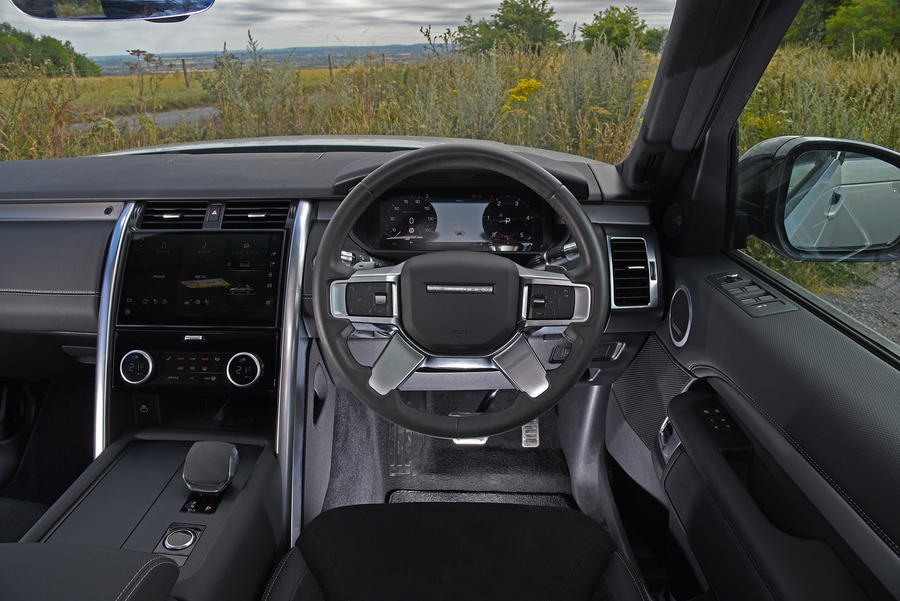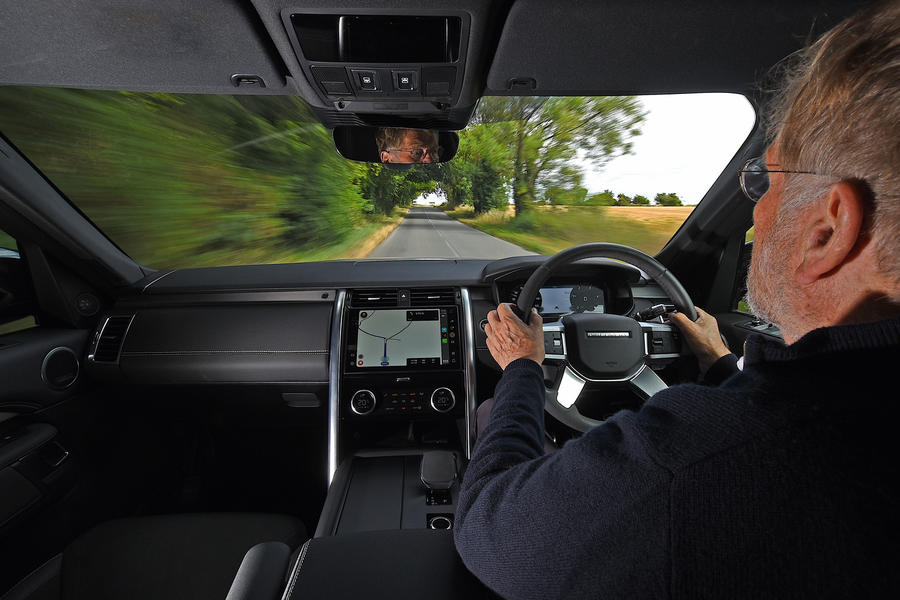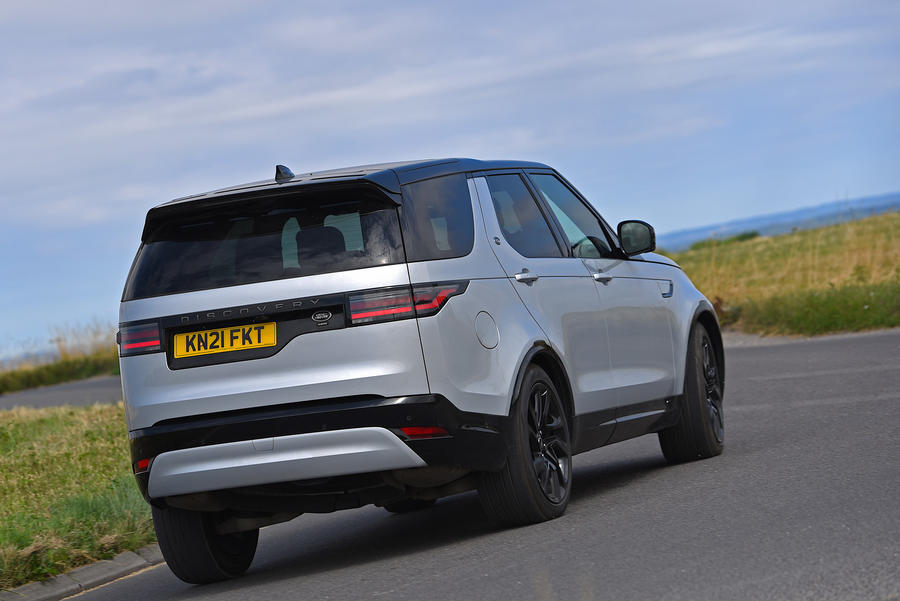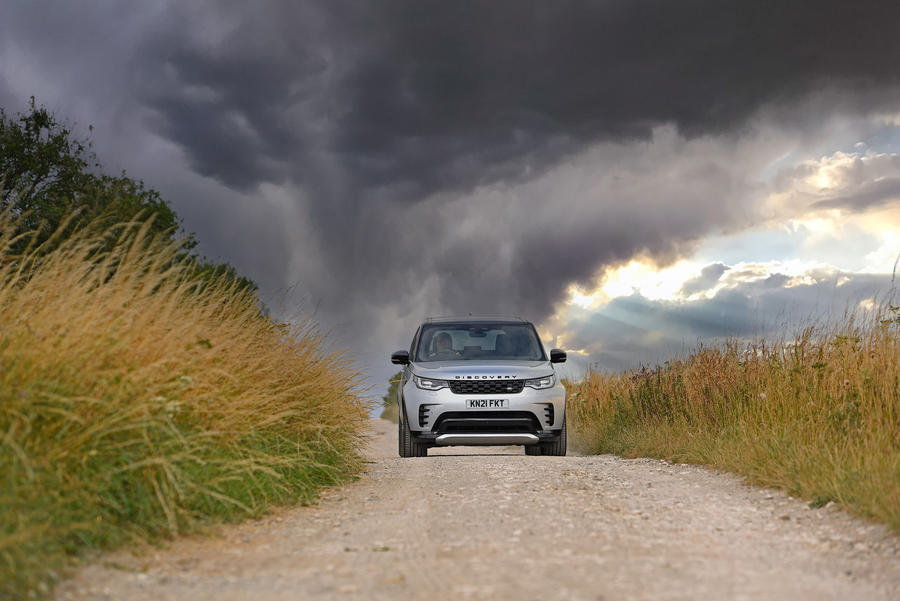Is there still a place for a big, capable 4×4 like this or have newcomers elbowed it out?
Why we’re running it: Is there still a place for a big, capable 4×4 like the Land Rover Discovery? Or have newcomers elbowed it out?
Month 2 – Month 1 – Specs
Life with a Land Rover Discovery: Month 2
Rear bench is a fine feature – 21 September 2022
One of the Disco’s best features is the trimmed black shelf that provides secure, spacious picnic- style seating for three when the lift-up door is opened, but also acts as a handy ‘fence’ when it’s closed, preventing loose stuff in the back from falling out when you open up. Everything retracts neatly when you press the ‘tailgate close’ button.
Mileage: 15,900
In few other cars will nearly 10,000 driven miles be so effortlessly amassed – 14 September 2022
My mileage in the Disco has climbed rapidly to around 8500 in just a few months, and in all that distance I’ve given very little thought to the engine.
I guess it’s because it’s so refined and unobtrusive – and because Land Rover slipped the 2996cc straight-six version of its mild-hybrid diesel into the range with only a fraction of the fanfare that greeted the original Wolverhampton- made Ingenium range.
Even so, I see from lots of time spent following other people’s full-sized Land Rovers that the six-cylinder has become a popular choice – and I’m rapidly learning why.
It idles smoothly and quietly. It pulls strongly from low revs (assisted no doubt by the MHEV’s integrated starter-generator). It is very smooth when operating in its maximum torque band (1500-2500rpm), and it easily supports a very tall top gearing. I continually find myself rolling smoothly along at 1500rpm in seventh or eighth gear, which helps deliver the Disco’s other overarching characteristic – effortlessness.
Hustling this car doesn’t always suit it, both because of its sheer size (width can be a problem in tight urban driving and on single-lane country roads) and its rather supple, luxurious low-speed ride. But when I do boot it, I find that the suspension tightens and the powertrain shows it can deliver 0-60mph in around 6.5sec (impressive for a 2.4-tonne car) while still yielding MPG in the late 30s.

That’s a cool 10-12mpg – or a hefty 40% – better than the V6 diesels in Discoverys made a decade ago, and the fact that the manufacturer gets scant credit for this improvement gets on my nerves. Better still is the touring range of 650-ish miles I’m promised when I fill the Disco’s mighty tank, admittedly at a current cost of £150- plus. There’s enduring satisfaction in knowing I can cruise a long way without stopping, especially in a vehicle so obviously built for long distances.
The comfort matches the long legs: the fabric-covered front seats are supportive over many miles, with the front-seat side bolsters especially effective at locating occupants against the side forces that sometimes go with fast progress in such a high-riding SUV.
Talking seats, there’s good space in the second row, especially since the vertical seating position ahead means front passengers don’t have to use much fore-and-aft movement. Second-row room is okay, too, though a mite claustrophobic for those of smaller stature, especially if the car has a black interior like ours. The third row is tolerable for two average adults, but not for too long.
The ride quality is often on my mind. There are times when I reckon the primary ride (the overall body control) could be better: the Disco can buck about quite a bit on bumpy roads taken fast. But the secondary ride (the way it absorbs ripples and deals with coarse surfaces) gets close to a Range Rover level, which gives an overall impression of luxury.
So what’s wrong with the Disco? Recent constant sun showed that, at least the way I sit in the car, there is often distracting glare from the shiny steering-wheel spokes. And because it’s my habit (perhaps not a good one) to jump into the car and get going quickly, there can be an uncomfortable period while the air suspension, which adopts a lower access mode when stationary, catches up with the driver’s intentions.
Last thing: that T-bar gear selector. You have to depress an oblong button at its leading edge to move out of Park or select Reverse, and the action is neither convenient nor intuitive. I’ve had 8500 miles of driving to think about this, and it’s not getting any better. What’s more, it’s the second time that JLR has adopted an ergonomically poor transmission selector. Please do better, Land Rover, but don’t change the Disco’s fundamentals. They’re terrific.
Love it
All-round ability
Whatever I need (comfort, cabin or load space, off-road ability or motorway competence), the Disco can provide it
Loathe it
Wider than a mile
The problem is its body width. It’s hard to park at the supermarket and won’t slip easily down a country road or a tight suburban street.
Mileage: 15,355
Steering wheel spokes shine a bright light… into Cropley’s eyes – 7 September 2022
A recent long run of bright days has thrown up a Disco foible: a dazzling reflection off the shiny steering wheel spokes that goes straight into your eyes when the sun is overhead. It’s an unusual fault in a car that will have been tested endlessly in the world’s hottest climes. Not much you can do about it either, apart from hoping clouds will soon roll by
Mileage:
Life with a Land Rover Discovery: Month 1
It’s quicker than it looks – 17 August 2022
I’m still getting used to our D300 Discovery’s poke. It’s a natural-born cruiser, with soft suspension and not much noise, so there are times when you forget that, if pressed, it will eat a column of dawdling cars on the Fosse Way for breakfast before setting back into its usual calm gait. Given the fuel consumption, which usually shows 40mpg on a trip, this is a surprising asset.
Mileage: 13,939
Welcoming the Land Rover Discovery to the fleet – 10 August 2022
Over five distinct models since 1989 (but only three different generations), the Discovery has played a surprising number of different roles in Land Rover’s line-up.
The first edition presented Landie lovers for the first time with a family-oriented model they could drive every day. It was pricey but not prohibitive. However, the coming of the smaller Freelander (now the Discovery Sport) and then the Range Rover Sport and Range Rover Evoque complicated things. Sophisticated, capable Land
Rovers positioned below the top price fllagship became common currency.TheDiscoverystarted running into own-brand competition.
The situation was further complicated when the current Disco 5 appeared in 2017, because its styling didn’t go down especially well with Discovery stalwarts (who to this day reserve warmer words for the tougher-looking Disco 4). And then came the 2020 debut of the new Defender, which offered similar powertrains and prices, plus a gigantic halo.

Disco sales struggled for a year or two with the arrival of a modernised mid-life model. But buyers came to realise that the model was (a) still a good thing and (b) the one you can buy, whereas the Defender is subject to a long waiting list and stock models are vanishingly rare.
That’s the basis for this story: what’s it like to run the full-sized Land Rover that you can actually get? Even our test car has followed the ‘what’s available’ principle: it was initially specified as a short-loans demonstrator, so it has already done 8000 miles. As with most things, this has good and bad aspects. Among the positives, there’s no need to run it in.
Among the negatives, there was no chance to deliberate over its specification and, of course, no showroom-fresh feeling, even though it came to us in perfect condition. Mind you, that ready-specified aspect can rapidly be turned into an advantage. How company people equip their own cars can be very telling. They know what matters – where the value is and what to leave out.
Thus our Disco 5 is a D300 R-Dynamic HSE, which makes it telling. They know what matters – where the value is and what to leave out. Thus our Disco 5 is a D300 R-Dynamic HSE, which makes it a fast and powerful, road-oriented seven-seater on the plush side of par – but with a relatively modest (for a Landie) suite of options that enhance its off-road capability and make it a great tow car. That’s the recipe for most people’s ideal Disco.
I’m hard to impress when it comes to specifying options, but I almost completely approve of this vehicle’s spec. The only things I would have left out are a £1900 heating system for the third row of seating (I will never use it) and the £490 privacy glass, because I happen to dislike the way black windows make cars look.
I have to acknowledge that they make life harder for those who nick stuff from cars, though. This is my third Discovery (I had a 3 and a 4 as well), and although it started its life less popular than the others, it has displayed exactly the same attributes as its predecessors during the 2000 miles that I’ve put under its wheels in barely a month.
First among them is unimpeachable practicality. It’s huge inside and very comfortable. The tailgate is vast but opening it is easy, and there’s a fold-out seating platform (less ritzy than the Bentley Bentayga edition, but arguably handier).
Tie-down turnbuckles are where you need them. The third-row seats don’t seriously impede carrying space and spring from the floor at the touch of a button.

But for me, the joy of the Disco is always going to be the driving. Once you get used to it, the size is usually a delight. There’s special enjoyment to be had in placing a big, stable car with nicely weighted, accurate but ever so slightly ponderous steering on narrow roads. Only in a car park does it become a serious bind.
If it didn’t sound so completely counterintuitive, I would say it was also even a pleasure to drive in the inner city, because of its great driver view, straight sides and the low-speed suppleness of the all-independent air suspension.
The last of those is a special treat: this car has active roll control, so it can afford to have relaxed ride rates, and they make it special. Of course, it’s a great road cruiser. It has terrific directional stability and plenty of road presence, so other road users mostly let you get on with doing what you want.
The Disco 5, with its integral body structure, isn’t quite as immune to motorway road noise as its two separate-chassis predecessors, but it’s still close to the top of the class. That modernised structure hasn’t helped much with the kerb weight: it’s still 2.35 tonnes, and you feel it on turn-in to tight corners and when you use the brakes even moderately hard.

Still, the fuel consumption has been a nice surprise, courtesy of its latest-tech 3.0-litre diesel with a discreet mild-hybrid system to help mostly with step-off from rest. I will usually see 40mpg on the trip computer (whose accuracy I’ve yet to check) anywhere but during extended town use. And when I fill the mighty 89-litre tank (which can cost £150 at present), I’m presented with a prediction of 740 miles. That’s a strong argument for the old ways.
Off-roading? I haven’t done any yet, but plans are afoot. Will it be any good? You might as well ask if a duck is watertight. I will report from one of the mud holes of the UK – if it ever rains again.
Second Opinion
I’m with Steve on the Disco’s dynamic appeal. So well matched is the silky steering to the generous roll rates that these cars are often more satisfying to flow down B-roads than overly firm and all-too-serious performance SUVs. I also like how unassuming the Disco is, relatively. The Defender is a bit of a fashion accessory now and the Range Rover an S-Class on stilts. The Disco feels more authentic and usable.
Richard Lane
Land Rover Discovery specification
Specs: Price New £67,290 Price as tested £75,120 Options Metallic paint £895, black roof £900, leather steering wheel £450, heated third- row seats £1900, active rear locking diff £1080, electrically deployable towbar £1130, privacy glass £490, wireless phone charging £300, Off-Road Capability Pack (transfer box, All Terrain Progress Control, configurable Terrain Response 2) £685
Test Data: Engine 2996cc, 6-cyl turbocharged diesel Power 300bhp at 4000rpm Torque 650lb ft at 1500rpm Kerb weight 2362kg Top speed 130mph 0-62mph 6.8sec Fuel economy 33.7mpg CO2 220g/km Faults None Expenses None
Source: Autocar
